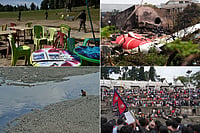The Camel Brigade's Canter
- The 800-strong contingent of BSF camels which patrols the 1,400 km Indo-Pak border in Rajasthan and Gujarat is trained to dodge bullets, transport rations, carry light artillery, rescue wounded men
- Camel-training is tough; the animals are very moody, have short memories, and quickly forget their training unless it's constantly reinforced
- BSF camels retire after 15 years service, and are sold at auctions where they're much sought after by local farmers
- The BSF has three breeds of camels-the racing Bikaneri, the tough Jaisalmeri, and the graceful, pedigreed Nachna, which is great for ceremonial occasions
***
Caparisoned in rich bridal attire, silver bracelets jingling, noses haughtily in the air, the camels of the Border Security Force's elite Camel Contingent bounce jauntily in time to the beat of the marching band. As they're put through their drill, they fan out gracefully into criss-cross formations, or lie docilely on their sides while soldiers perform yogasanas and PT exercises on them.
While this 100-strong contingent is integral to the pomp and pageantry at the Republic Day parade in Delhi, 700 other BSF camels toil quietly in remote outposts scattered along the 1,400-km-long border with Pakistan in Rajasthan and Gujarat, at Sriganganagar, Bikaner, Jaisalmer, Barmer and Bhuj. Here, their duties include checking infiltration of smugglers and insurgents, rescuing soldiers bitten by snakes and scorpions, and transporting mail, rations and men to remote, inaccessible areas through punishing desert weather: blinding sandstorms, blistering heat and bitter cold.
It's a long journey that transforms this seemingly ungainly ship of the desert into border vigilante and scene-stealer at the Republic Day parade. Five-year-old male camels are first carefully selected from fairs—chosen for healthy golden coats, good eyesight, and, most importantly, a proud demeanour. "A drooping head symbolises low morale, which is something we people in uniform don't appreciate!" says Kamal Singh Rathore, deputy commandant and instructor at the Jodhpur camel training centre.
At this centre and another one in Bikaner, the camels undergo rigorous training for up to a year. Regular grooming, brushing and feeding helps build a rapport between the camels and their trainers, essential for turning them into lean and tough warriors, a coiled spring at the ready. Slowly, the camels are coaxed into obeying commands, such as sit down (Jai, jai), get up (Uth, uth), and drink water (Prak, prak). Once these are mastered, the camels are taught more advanced "soldierly commands", such as buckling down and crawling on bended knees to duck gunfire. They also learn tactical moves—in the case of a surprise ambush, for example, they're trained to lope along nonchalantly, while the jawans riding them shield themselves by clinging to their side.
Working with camels is particularly demanding, say the BSF men. For one, camels have a very short memory, and hundreds of hours of training will be completely undone if they're left idle for two days. And then, they're notoriously moody. The trainers keep a sharp eye on the camels' body language—a camel that suddenly tilts its neck to one side, for instance, means that it's in a temper and about to lunge forth and bite you. Winter, the camel's rutting period, poses even more problems, as Rathore observes: "They growl, foam at the mouth, refuse to obey commands, and get very aggressive when they smell a female camel around!" During this time, rope muzzles are used to keep frustrated, amorous camels from furiously chomping on BSF jawans. The muzzles also serve to protect the beasts from themselves: during the mating season, male camels let a livid, hollow sac burble out of the side of their mouth to display dominance, and this sometimes gets stuck in their giant yellow teeth with the most painful consequences.
It's these muzzled, petulant sentinels that pace the 10-km stretch of Dhanasar Forward, a remote border observation post 100 km from Jaisalmer, an arid terrain of undulating sand dunes which sustains nothing but sevan grass, and few ker and babul trees. Just 150 yards away is a line of white pillars, marking the international border. Here, three times a day, the BSF camels patrol the sandy track bordering a barbed wire fence, while their riders check for footprints. Four kilometres away, camel-mounted Pakistani troops are doing much the same thing at their border posts of Bhuri Bhit and Silvari Bhit.

The BSF’s camel contingent patrols the India-Pak border near Jaisalmer
The footprint-checking usually yields nothing more exciting than pawprints of foxes and dogs, but with vivid memories of skirmishes in 1971 and 1965, a 24-hour vigil is nevertheless maintained. As darkness falls on the desert, powerful floodlights illuminate the fencing track through the night, while from isolated machans scattered across the dunes, jawans keep watch on the goings-on across the border.
At the camel stables a little distance away, Dhanasar camp commandant and Rajasthan native Rameshwar Lal Bishnoi points out the three distinctive breeds that the Camel Corps are composed of: "The Jaisalmeri has thick thighs, the Bikaneri runs fast, and the Nachna is the pedigreed variety, which you can tell apart from the haughty way it holds its head up high."
Haughty as well as high-maintenance, all camels serving their 15-year tenure with the BSF daily enjoy a lavish diet of 10 kg of fodder, composed of gowar and ber leaves, as well as channa, wheat and mustard stalks. This is topped up with fortified laddoo, providing each camel a carefully worked-out nutrition of proteins, carbohydrates and vitamins. Overworked or angry camels are plied with treats of gur to coax them back into good humour. "Khao, Pintu, khao," a jawan placates his sulking camel in cooing tones. Such affectionate nicknames are, however, reserved for private moments—while on parade or on patrol duty, soldierly discipline is maintained and the camels are called only by their official names. Pintu, for example, is "R-41".
Though unadorned while going about their quotidian tasks, the camels sport lavish uniforms for the BSF's ceremonial occasions. Like cross-dressing queens at carnivals, they're both fearsome and resplendent in their beaded necklaces, exquisite silver knee-bracelets, intricately braided and bound up tails, and tasselled headdresses studded with mirror-work.
Bare or bejewelled, when it comes to their utility in the harsh desert terrain, Rathore thinks four long legs will never be surpassed by four-wheeled suvs: "Camels are cheaper, they cost only Rs 90 a day, and they're eco-friendly—no polluting fumes, no punctures or breakdowns, no spare parts required!"


























